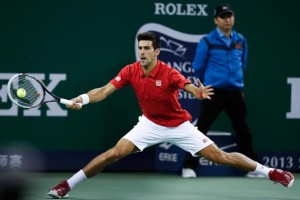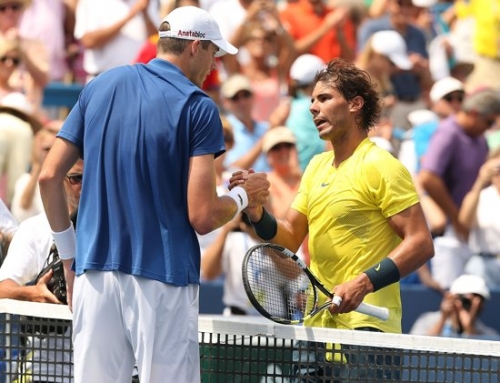 Back in 2009, the biggest ask in men’s tennis was beating both Roger Federer and Rafael Nadal in a Slam, The two had such divergent styles, and yet both were huge winners. It was a daunting task for anyone to beat both. Ask Robin Soderling, still the only man to beat Rafael Nadal at Roland Garros, who, that year, did the unthinkable and beat Rafael Nadal. Soderling, for his part, followed that upset and worked his way to the final beating Davydenko and Gonzalez en route to the finals against Roger Federer, a player he had had little success again. Federer, of course, had to thank Soderling for giving him an opponent he could beat at a French final, and finally allowed Federer to complete the career Slam.
Back in 2009, the biggest ask in men’s tennis was beating both Roger Federer and Rafael Nadal in a Slam, The two had such divergent styles, and yet both were huge winners. It was a daunting task for anyone to beat both. Ask Robin Soderling, still the only man to beat Rafael Nadal at Roland Garros, who, that year, did the unthinkable and beat Rafael Nadal. Soderling, for his part, followed that upset and worked his way to the final beating Davydenko and Gonzalez en route to the finals against Roger Federer, a player he had had little success again. Federer, of course, had to thank Soderling for giving him an opponent he could beat at a French final, and finally allowed Federer to complete the career Slam.
Fast forward to the US Open when Juan Martin del Potro would do just that. He clobbered Rafael Nadal in the semis though Nadal may have suffered from abdominal issues. Then, he weathered the storm with Federer trying to serve out a 2-set to none lead, but stubbornly tried to attack the Delpo forehand. Delpo would take the second set. Federer would then take the third set, but Delpo would gain enough confidence that he took sets 4 and 5.
del Potro is still the last player that’s not part of the “top 4″ to win a Slam, though he would get his first (and only) Slam way before Andy Murray who wouldn’t win his first Slam until the US Open.
These days, with Roger Federer in apparent freefall, struggling to even reach a semifinal of a regular ATP tournament, let alone a Slam, is no longer that threat. The big one-two is now Rafael Nadal and Novak Djokovic.
del Potro’s progress up the ranks was derailed back in 2010 when he needed surgery on his wrist. When he came back, he wasn’t quite the dominant player that ended 2009. His intimidating forehand had been replaced by a more defensive style. del Potro built his backhand to be a steady side where he could trade long crosscourt rallies with practically anyone, so he could dare players to hit to his more daunting forehand.
It took about 2 years before del Potro has started looking more like del Potro of old, and this culminated in a semifinal encounter with Nadal. The two had met earlier in the year in the finals of Indian Wells which Rafael Nadal won in three sets.
It came as a great surprise when del Potro chose to play Nadal the way everyone plays Nadal, which is with power. It’s not SO surprising that players play this way, but it is surprising how effective del Potro was. In particular, del Potro wanted to move Rafa side to side, and go for hard down the line shots when pulled to his right.
The biggest difference between most players playing Rafa this way and del Potro is that it feels like del Potro is playing within himself, that he isn’t playing a crazy style for him. A player like Ryan Harrison, for example, often hits big because he has no choice. If he hits what is a comfortable shot for him, Rafa is likely to take advantage of the shot, so Harrison throws caution to the wind, and invariably, it appears the shot has been taken by the wind and send flailing out.
The key to del Potro beating Nadal was threefold. First, he was able to use power shots, both of forehand and backhand, to move Rafael Nadal scampering side to side, often futilely. Second, he was steady enough to hit 5-6 or more power shots without missing. Most players that play a power style have only maybe 2 good hard shots before they cough up an error against Nadal who does an incredible shot getting shots back. Third, and perhaps just as important, del Potro did an incredible job fighting off break points.
In the end, no matter how good you are, if you’re going to be a champion, you have to be able to fight off break points. Federer used to do it. Djokovic can do it. Nadal can do it. Murray can do it. del Potro seems like he has the right tools to do it too, namely, a big serve, and power shots. But, he has to do it when it matters. Those big shots have to land in when he needs it most.
You knew del Potro was having a good day when he was able to break Nadal’s serve, something no one else had done the entire tournament. For as well as a player like Wawrinka played Nadal (at least for a set in their quarterfinal match), he couldn’t break Nadal. Nadal protects his serve as well as anyone.
While del Potro had as confident a win over Nadal, it’s one thing to beat Nadal, and it’s another to beat Djokovic.
In a weird way, though perhaps not that weird, all the work Djokovic has done to beat Nadal, something he only did last week, has helped him handle other players as well. The key to Djokovic beating Nadal was to hold serve, and to hit down the line off forehand and backhand. Where Nadal would opt to play a bit more defensively when put in trouble usually looping a high lefty looper, Djokovic is more likely to play more straight up, taking the power and redirecting down the line.
If del Potro has a weakness, it’s that a player of his stature, 6’6” in height, he’s not the quickest player. He hides his speed issues perhaps better than anyone his height. He can hit a mighty forehand on the run, and even the threat of that huge forehand forces players to aim to his backhand thus making him have to cover less ground.
The first four games looked like the del Potro-Nadal semi with del Potro playing the role of Nadal. Djokovic looked crisp, absorbing del Potro’s power, on his way to a two break lead, and it looked like that storybook run would end in disaster. Djokovic would take the first set 6-1.
However, in a inexplicable set of games at the start of the second set, Djokovic not only started missing first serves, he also started losing his balance, not just one time, but several times. He would hit a forehand, and on the follow-through, look like he was bending over backwards in a limbo contest. del Potro didn’t mind the odd gift, and earned an early break. With the tall Argentine now firmly in the match and not being blown out, the match stayed a lot closer.
From that point onward, the two held serve. del Potro was able to fend off break points in both the second set and third set as was Djokovic. del Potro took the second set 6-3.
The third set was pretty much waiting for the tiebreak as there were no breaks of serve in 12 consecutive games.
The tiebreak was then Novak being Novak, hitting the big shots when he needed to, and beating del Potro 7-3 in the tiebreak. del Potro, who had played Djokovic so close in the Wimbledon semifinal, came up short once again, and covered his head in a towel, unable to process what had happen to him. Djokovic tried to make him feel better during the post-match award ceremony saying he felt del Potro also deserved the trophy. del Potro appeared to make a comment (probably saying he wanted the trophy in that case) which left Djokovic laughing incredulously (“well, of course, you can’t have the trophy” his laugh seemed to say).
And with this win, Djokovic has won his 15th Masters 1000 title, and is creeping closer to Andre Agassi who has won 17 Masters 1000. In a day and age when winning Slams is now the benchmark of greatness, winning Masters 1000 titles appears to be a close second. It’s not surprising that two of the top 3 winners of most Masters 1000 are currently active players in Nadal and Federer, and that Djokovic, when all is said and done, is likely to join them.
The tour now moves to Moscow, Stockholm, and Vienna in the last part of the ATP Tour. Next week, there will be two more ATP 500 events: Basel and Valencia, followed by the last Masters 1000 of the year in Paris. The following week is the year-end championships in London, and the men will pretty much have the rest of November and December off aside from Davis Cup.
With del Potro reaching the finals, he becomes the fifth player to qualify for the year-end championship after Djokovic, Nadal, Ferrer, and Murray. Murray has already said he won’t play London, needing that time to recover from back surgery that he took shortly after the US Open.
Roger Federer also announced during the weekend that he would no longer be working with Paul Annacone. While working with Annacone, Federer did win one more Slam (Wimbledon 2012), a silver medal at the Olympics, and regained the number 1 rank to finally break Sampras’s record weeks at number 1 (Federer had trailed Sampras by a week for sometime, and with Djokovic having a monster 2011, it was hard to believe he’d ever get back to number 1).



![[Paris] Djokovic finishes post US Open tournaments undefeated with win over Ferrer](https://www.essentialtennis.com/wp-content/uploads/2013/11/20131103nole-500x383.jpg)
![[Shanghai, SF] del Potro upsets Nadal in awesome display of power](https://www.essentialtennis.com/wp-content/uploads/2013/10/20131012delpo-500x383.jpg)

![[Cincinnati] Nadal wins 26th Masters 1000 title with win over Isner 7-6, 7-6](https://www.essentialtennis.com/wp-content/uploads/2013/08/20130818rafa-500x383.jpg)
![[Montreal] Nadal crushes Raonic to win 25th Masters 1000 title](https://www.essentialtennis.com/wp-content/uploads/2013/08/20130811nadal-500x383.jpg)